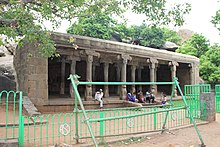Krishna Cave Temple
| Krishna Mandapam | |
|---|---|

Entrance to the Krishna Mandapa
|
|
| Geography | |
| Coordinates | 12°37′00″N 80°11′30″E / 12.6167°N 80.1917°ECoordinates: 12°37′00″N 80°11′30″E / 12.6167°N 80.1917°E |
| Country | India |
| State | Tamil Nadu |
| District | Kancheepuram district |
| Location | Mamallapuram |
| Culture | |
| Sanctum | Lord Krishna |
| Architecture | |
| Number of temples | 1 |
| Inscriptions | Inscribed in 1984 under Asia-Pacific of UNESCO |
| History and governance | |
| Date built | Mid-7th century |
| Creator | Pallava dynasty |
Mandapa of Krishna or Krishna Mandapam is a monument at Mahabalipuram, on the Coromandel Coast of the Bay of Bengal, in the Kancheepuram district of the state of Tamil Nadu, India. It is part of the Group of Monuments at Mahabalipuram, a UNESCO World Heritage Site inscribed in 1984. It is located on a hillock next to the open rock relief of Descent of the Ganges (Mahabalipuram).
It is constituted by an originally open-air bas-relief dedicated to Lord Krishna, dating to the mid-seventh century, which was later enclosed within a mandapa in the 16th century during the Vijayanagara Empire. Notable carvings inside are sculpted panels that bring out the myth of Krishna lifting the Govardhana Hill to protect the cowherds and gopis (milk maids) from heavy rains and floods – the "most poetic and endearing" Indian or Angkor sculpture-based representation of this legend – and there are also scenes of Krishna frolicking with the milk maids.
The building facing east has a length of 29 feet (8.8 m) and height of 12 feet (3.7 m). It is a pillared mandapa.
The structure shelters nine reliefs carved on the rock surfaces, all dated to the 7th century but further refurbished with additions made in the 16th century.
One prominent relief depicts Krishna lifting the mythical Govardhana Hill on the finger of his left hand to save the people from a deluge caused by rains showered by Indra. People with their cattle are shown taking shelter under the mountain. The myth related to this depiction is linked to Indra. Indra was annoyed with the people of the village (now Mathura) as they had discontinued celebration of a festival in his honour. He created a huge storm with heavy rainshowers, threatening the life of the villagers. Krishna, who was from the same village, lifted the Govardhana Hill (near Mathura), creating an umbrella of protection and saving the village, its people, and the cowherds. In this relief, Krishna is flanked by three females to his right; one of them is inferred as Radha, his childhood lover, as she is shown wearing a kirita makuta crown, a breast band, and many ornaments. On his right stand two figures, one male and one female. In addition, there are several other images in the panel of animals and village folk.
...
Wikipedia

